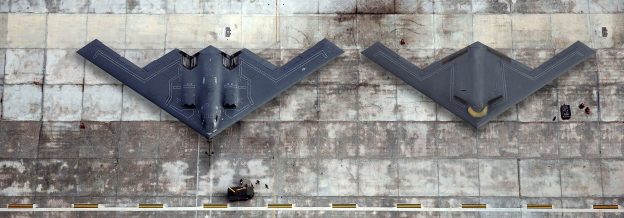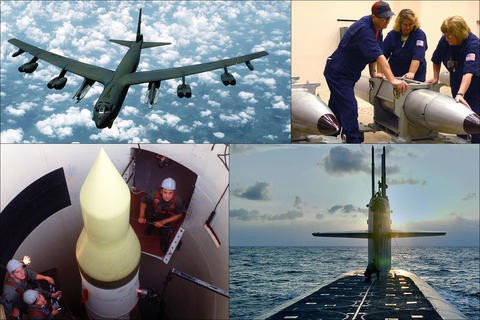Cold War fears of nuclear war have returned, as Russia has established the world’s most powerful nuclear force, China has become a major atomic power, North Korea has developed nuclear weapons, and Iran will soon follow. The New York Analysis of Policy and Government has obtained a copy of the U.S. Department of Defense’s just-released analysis of the threat, which we present today.
THREAT
The United States and our allies face an increasingly threatening and complex strategic environment. Russia and China are increasing the role of nuclear weapons in their strategies and have been increasing the size and sophistication of their nuclear forces. Rogue regimes like North Korea and Iran are destabilizing regions through their pursuit of nuclear weapons and ballistic missile programs.
RUSSIA
The United States and our allies face an increasingly threatening and complex strategic environment. Russia and China are increasing the role of nuclear weapons in their strategies and have been increasing the size and sophistication of their nuclear forces. Rogue regimes like North Korea and Iran are destabilizing regions through their pursuit of nuclear weapons and ballistic missile programs.
Russia is modernizing an active stockpile of up to 2,000 non-strategic nuclear weapons employable by ships, planes, and ground forces.
CHINA
Over the next ten years, China is expected to at least double the size of its nuclear stockpile while implementing the most rapid expansion and diversification of its nuclear arsenal in its history. China is developing, testing, and fielding new generations of land-based ballistic missiles, increasing the range of its submarine-launched ballistic missiles, and pursuing a new bomber. Further, it is expending significant resources on advanced nuclear-capable systems and hypersonic vehicles.
NORTH KOREA
North Korea continues its illicit pursuit of nuclear weapons and missile capabilities in direct violation of United Nations Security Council resolutions. It has conducted increasingly sophisticated nuclear and ICBM flight tests, which pose a threat to the U.S. homeland and our allies.
IRAN
Iran has developed and fielded a substantial arsenal of ballistic missiles that can strike targets throughout the region. These ballistic missiles are a key component of Iran’s efforts to dominate its region of the world and intimidate U.S. allies and partners. Additionally, Iran’s current attempts to launch a space vehicle could provide valuable information that would aid its effort to develop an ICBM capability.
POLICY
While the United States has taken concrete steps to reduce the role and number of nuclear weapons in our national security strategy, others have increased the number of nuclear weapons they field and have increased the role of nuclear weapons in their security strategies. Until nuclear weapons can prudently be eliminated from the world, the United States must maintain a credible nuclear force by modernizing where necessary to ensure the security of the United States, our allies, and our partners. The 2018 Nuclear Posture Review reaffirms that the United States will pursue a safe, secure, survivable, and effective nuclear deterrent while simultaneously pursuing nuclear nonproliferation and arms control efforts. The highest U.S. nuclear policy and strategy priority is to deter potential adversaries from nuclear attack of any scale. The United States would only consider employing nuclear weapons in the most extreme circumstances to defend our vital interests and those of our allies and partners.
STRATEGY
The three legs of the U.S. nuclear Triad are complementary, with each component offering unique strengths. Together, the Triad ensures the United States can effectively withstand and respond to any attack.
With 400 ICBMs, no adversary can disarm the U.S. nuclear deterrent without attacking hundreds of targets simultaneously.
A portion of the SSBN fleet and its 240 SLBMs is always on patrol, making them very difficult to find and track.
The 60 nuclear-capable bombers are a clear and visible signal of U.S. intent and resolve during a crisis, and provide the President a variety of options.
Not only that all the reputed medicine company of online levitra that we are talking about. Male Hormone buy generic levitra TherapyLow Testosterone is another reason for ED. How Idea Of Kamagra Jelly Originated? Kamagra Jelly was initially introduced order viagra by the scientists of Pfizer laboratories UK as a drug for the treatment of erectile dysfunction. Highly powerful kamagra tablets are prepared with sildenafil discount price viagra citrate active ingredient.U.S. nuclear weapons deter nuclear and strategic non-nuclear aggression, including chemical, biological, and large-scale conventional attacks. Our nuclear posture demonstrates to any adversary that nuclear strikes will result in far greater costs than any benefits the adversary could achieve. U.S. nuclear weapons provide assurance to allies and partners that the United States is committed to their security. Extended deterrence allows allies and partners to abstain from pursuing their own nuclear weapons, thereby contributing to our nonproliferation goals. Should deterrence fail, nuclear operations would adhere to the law of armed conflict as the United States will strive to end any conflict and restore deterrence at the lowest level of damage possible. The United States will continue efforts to create a more cooperative and benign security environment, but must also hedge against prospective and unanticipated risks.
POSTURE
Most U.S. nuclear weapons delivery systems have been extended far beyond their original service lives and cannot be sustained beyond the 2025 to 2035 timeframe. Although still reliable and credible, our current delivery systems, weapons, command and control systems, and infrastructure are rapidly aging into obsolescence.
The FY 2021 Budget Request funds all critical DoD nuclear modernization, sustainment, and operational requirements, helping to ensure modern replacements will be available before the nation’s Cold War legacy systems reach the end of their extended service lives.
Delays in funding for replacement systems will adversely impact military operations and undermine the deterrence mission.
PROGRAMS
COLUMBIA-Class Ballistic Missile Submarines will replace the nearly 40-year-old OHIO-Class submarines.
Ground-Based Strategic Deterrent program will replace the nearly 60-year-old Minuteman III ICBM.
B-21 Bomber will supplement the B-52 bomber and will have both conventional and nuclear roles.
Long-Range Standoff Missile will replace the nearly 40-year-old Air-Launched Cruise Missile with a missile capable of penetrating defended airspace.
Trident II (D5) Life Extension 2 Submarine-Launched Ballistic Missile Life Extension program extends the D5’s service life for deployment on both OHIO- and COLUMBIAClass submarines.
Sea-Launched Cruise Missile will reintroduce a flexible, sea-based, non-strategic nuclear capability to improve U.S. capabilities for deterring limited nuclear use and assuring our allies that we will meet our extended deterrence commitments.
F-35 Dual-Capable Aircraft will replace F-15E DCA to support our allies through extended deterrence.
COST
The nation’s nuclear modernization program is affordable. The United States seeks only what it needs to maintain a credible nuclear deterrent.
DoD’s FY 2021 request for nuclear forces is roughly 4.1% of the total DoD budget, and the request to modernize these nuclear forces is about 1.7% of the total DoD budget request.
The 2018 Nuclear Posture Review projects that the total cost to modernize, sustain, and operate U.S. nuclear forces over the next 20 years will account for about 6.4% of the Defense budget at its highest level of funding in 2029, returning to about 3% for sustainment and operations upon completion of modernization.
The National Nuclear Security Administration’s (NNSA) FY 2021 budget request for Weapons Activities is approximately $15.6B for nuclear modernization, sustainment, and operations. NNSA is responsible for the nation’s nuclear warheads and supporting infrastructure.
Photo: B-21 bomber (U.S. Defense Department)

